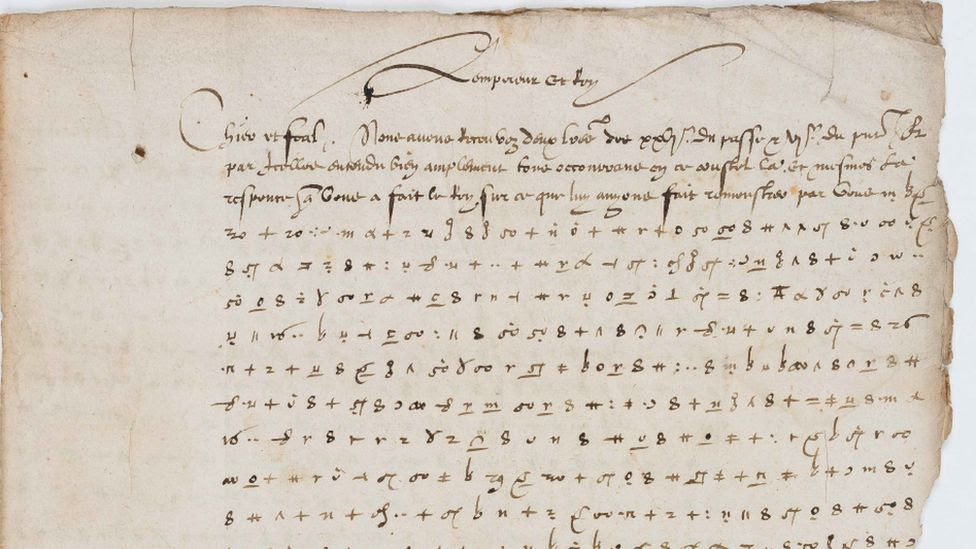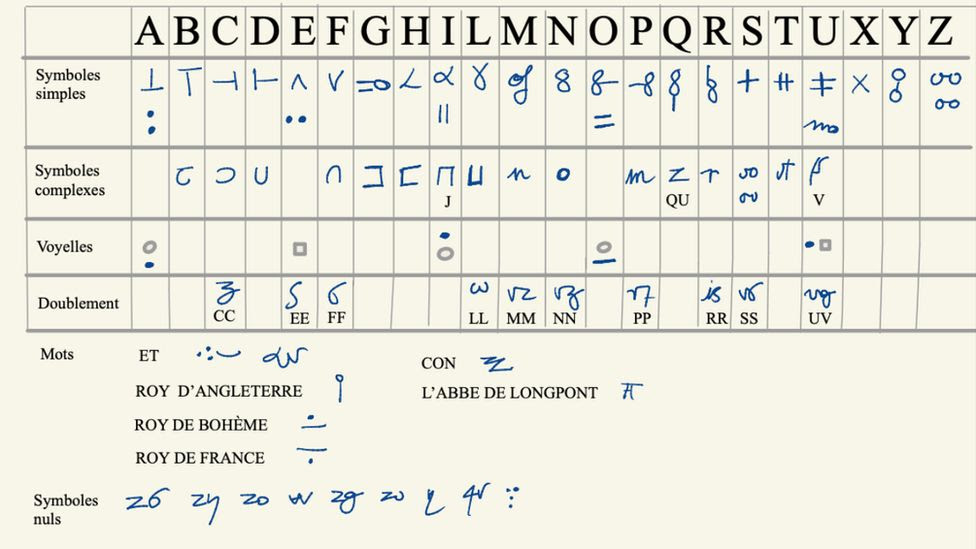Decoding an emperor's letter: the dark arts of diplomacy
« previous post | next post »
BBC (11/27/22) article by Hugh Schofield:
"Charles V: French scientists decode 500-year-old letter"
A coded letter signed in 1547 by the most powerful ruler in Europe has been cracked by French scientists, revealing that he lived in fear of an assassination attempt by an Italian mercenary.
The article begins like a historical mystery novel:
Sent by the Holy Roman Emperor Charles V to his ambassador at the French royal court – a man called Jean de Saint-Mauris – the letter gives an insight into the preoccupations of Europe's rulers at a time of dangerous instability caused by wars of religion and rival strategic interests.
For historians, it is also a rare glimpse at the dark arts of diplomacy in action: secrecy, smiling insincerity and disinformation were evidently as current then as they are today.
Cryptographer Cecile Pierrot first heard a rumour of the letter's existence at a dinner party in Nancy three years ago. After lengthy research she tracked it down to the basement of the city's historic library.
It's a fascinating tale, since we know many of the historical details that go along with and assist the decoding.
Setting herself a challenge to decode the document within a few days, she was disconcerted to find the task rather harder than she had thought.
The three-page letter – consisting of about 70 lines – is mainly written using about 120 encrypted symbols, but there are also three sections in plain contemporary French.
"The first thing was to categorise the symbols, and to look for patterns. But it wasn't simply a case of one symbol representing one letter – it was much more complex," says Pierrot.
"Simply putting it into a computer and telling the computer to work it out would literally have taken longer than the history of the universe!"
Wait a minute! That sounds like gross hyperbole to me. Take a look for yourself. Here's the opening portion of the coded letter:

Image source, BIBLIOTHÈQUE STANISLAS DE NANCY
It's easy for me to spot the same symbols regularly recurring. Even though it may not have been "simply a case of one symbol representing one letter", the whole set of encrypted symbols amounts to a manageable amount of around 120. My brain is not as powerful as a computer, and I only have several decades to apply myself to the task, but I'm confident that — if somebody paid me handsomely to do it — I would make significant progress toward decoding the letter in far less time "than the history of the universe" from the beginning up to now — "literally", as Pierrot claims.
Related links to this story may be found here and here, and there are many others that may be located by Googling "Charles V decode". Unfortunately, none of the links explains the decoding process, but there was a Rosetta-Stone methodology used. Well, well, well! If I had that Rosetta Stone, I'm pretty confident that I could decode Charles V's encrypted letter in less than half the time from the beginning of the history of the universe up to now — literally.
I only wish the articles had been more specific about how the decoding was accomplished, but that makes sense given "The team has not yet issued a full translation, which they are saving for an academic paper. But this week they set out the themes."
In other words, these articles are teasers, not trailers.
Here's the table of correlations that Pierrot and colleagues came up with:

Image source, BIBLIOTHÈQUE STANISLAS DE NANCY
The rarity of the letter 'e' is a sign that the codemakers knew their stuff. Because 'e' is the most common letter (in old as in modern French), it is what codebreakers would be looking for first. And the fake symbols were simply put in to sow more confusion.
They deserve credit for that, but I will be waiting for their academic paper to see exactly how Pierrot's team arrived at their decipherment and how what they did could not have been done by a well-programed computer in a finite amount of time.
Selected readings
- "Inscription decipherment with digital image enhancement" (12/1/20)
- "Toward the decipherment of Harappan" (2/14/22)
- "Decipherment of Linear Elamite" (9/5/22)
- "Unknown Language #12" (7/18/20)
- "Ancient Greek and Roman shorthand" (11/9/22)
- "Unknown language #14" (10/27/22)
- Chinese restaurant shorthand, part 6" (6/17/19)
[Thanks to Francois Lang]
Seth said,
November 30, 2022 @ 12:40 am
The "history of the universe" bit is probably from evaluating all potential keys which might be used for the encryption. That can indeed take a cosmically long amount of time. The breakthrough might have been something like "Try his first wife's maiden name" (and finding someone who knew it!).
By Rosetta-Stone methodology I suspect they mean they got some insight into what he used for keys, from other known messages. Not an exact copy of the plaintext message itself.
Mark Young said,
November 30, 2022 @ 11:43 am
She was probably referring to that famous CS technique known as BFI. In this case, just keep trying different character sequences for each symbol until the output makes sense. One hundred and twenty symbols, each representing a zero-to-twenty-character sequence (observed answer), with characters selected from letters, digits, punctuation and the space would yield a program that needs to test about 3*10^16 possibilities per second in order to check all possibilities within the age of the universe.
If you limit the length of sequence to three characters, BFI could work thru the options in a reasonable time, but it would not find the correct sequences for the four people with their own symbols. It would take a (very) tiny bit of clever programming to get the automated testing program to accept partial solutions.
The important point being that she is not talking about a well-programmed computer.
Steve Morrison said,
November 30, 2022 @ 9:04 pm
According to this article, the “Rosetta Stone” was another coded letter whose recipient had made a translation.
M. Paul Shore said,
December 1, 2022 @ 7:01 am
What is the presumably French word “con” doing there in the table of correlations? Remember, this is not Italian or Spanish, where “con” would mean “with”. Did the preparer of the letter routinely, perhaps with whimsical intent, substitute a macaronic “con” for the French “avec”, and use a special symbol to represent it? Did he additionally or alternatively, perhaps also with whimsical intent, use a special symbol every time the letter-sequence “c-o-n” appeared? Was “Con” someone’s nickname or code name? Was “CON” someone’s initials? Did “con” have some now-forgotten relevant meaning in the 16th century? (unfortunately, I don’t have a dictionary of Middle French easily at hand as I write this), And finally, is the symbol for “con” intended to carry some scurrilous graphical significance?
Peter Grubtal said,
December 1, 2022 @ 11:02 pm
@M. Paul Shore
Are you aware of the meaning of "con" in modern French?
Maxwell said,
December 2, 2022 @ 11:31 pm
@ Peter Grubtal. I believe that M. Paul Shore was quite aware of it (cf. his use of the word "scurrilous").